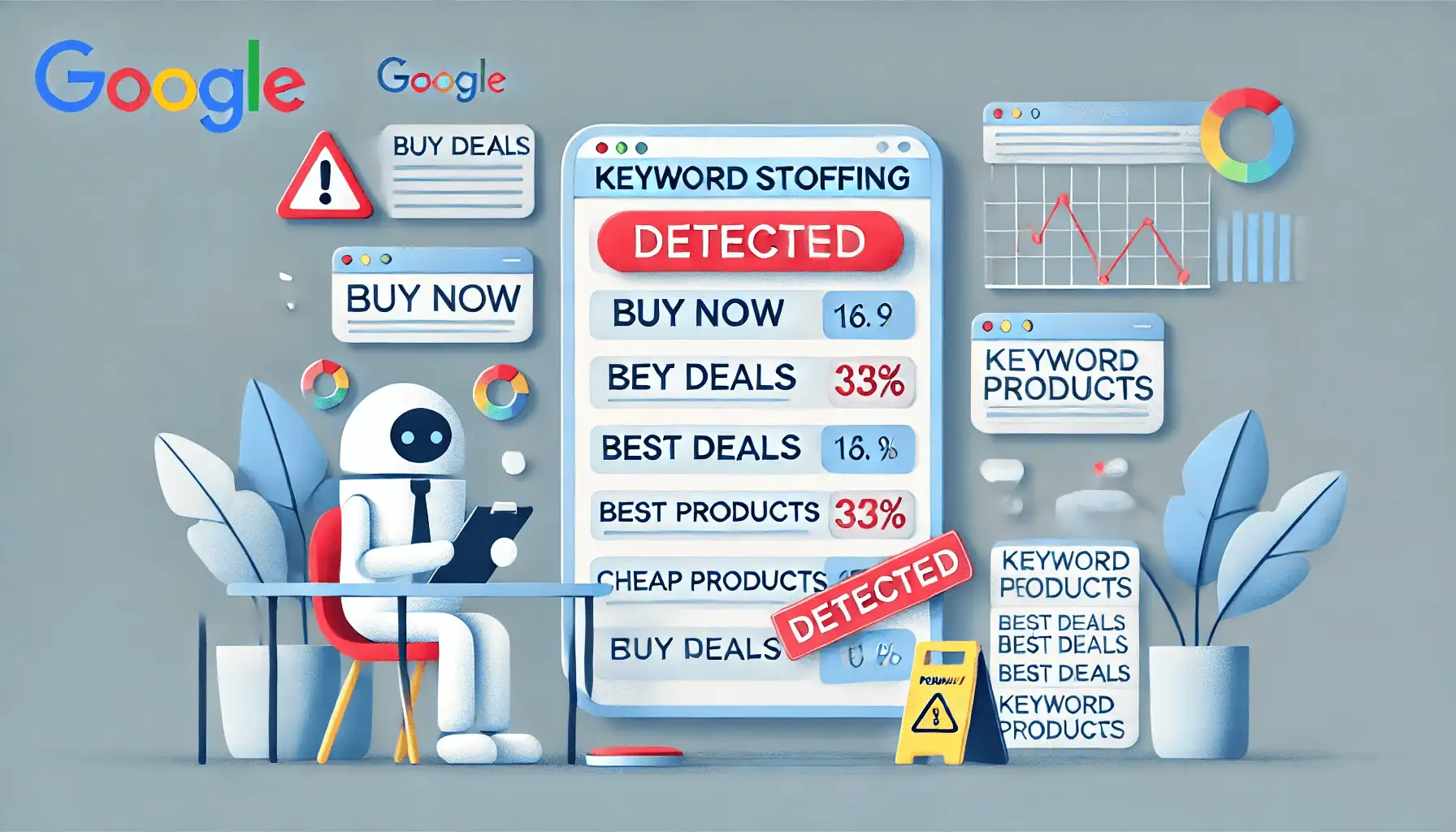Read Our SEO POST:
Keyword stuffing in SEO and How to Avoid It
Learn how to SEO your Website!Tips & Tricks about Content, Local or Technical SEO optimization for every website
Keyword stuffing in SEO and How to Avoid It
What is Keyword Stuffing in SEO? It is the practice of overloading a web page with keywords or phrases in an attempt to manipulate a site’s ranking in Google’s search results (SERPs).
This outdated black hat tactic involves the excessive repetition of keywords, often at the expense of readability and user experience. It’s a “spammy SEO tactic“, that violates Google’s spam policies, and can lead to penalties from search engines. Modern search algorithms prioritize user experience and natural language, making keyword stuffing ineffective and potentially harmful to a website’s reputation and visibility.
🎧 SEO My Website Podcast Episode
Feeling lazy to read the whole article?
Listen to our short expert talk about SEO strategies and keyword optimization.
Need help optimizing your website? Contact our SEO experts.
🔴 What are examples of keyword stuffing:
A. Visible Keyword Stuffing:
– Excessive repetition of the same words or phrases, often making the content awkward, repetitive, and difficult to read.
– Inserting multiple variations of a keyword that sound unnatural.
– Using irrelevant or non-contextual keywords.
– Placing blocks of keywords (keyword spamming).
– Listing phone numbers without context or purpose.
– Listing blocks of cities or regions to manipulate local rankings.
– Using overly keyword-rich anchor text in backlinks.
B. Invisible Keyword Stuffing:
* Matching text font colour to the webpage’s background color.
* Placing text behind images.
* Positioning text off-screen.
* Using extremely small, unreadable font sizes (e.g., 1px or less).
* Inserting keyword-loaded text in the web page’s code, such as HTML comments or meta tags (like meta titles, descriptions, and image alt tags) unnaturally.
* Hyperlinking just one character (like a period or dash).
* SEO Cloaking , which is a black hat tactic, where a website shows different content to search engines and to human users. This Black Hat tactic is often used to manipulate search rankings, by adding multiple SEO keywords in an unnatural way.
🔴 But Why is Keyword Stuffing Bad for SEO?
Here are the 5 most common reasons why stuffing keywords hurt more than it helps:
- Penalties from Search Engines: This is the most frightening consequence. Google and Bing have become adept at detecting keyword stuffing. And the major question is: Does Google penalize keyword stuffing? Well, If a website is caught engaging in this “black-hat SEO tactic”, it can be penalized, resulting in lower rankings, demotion, or even removal from search engine indexes and results. These penalties can severely impact your site’s visibility and traffic. Recovery can take months of hard work, with some sites never fully recovering their rankings. Google has released numerous algorithm updates specifically to devalue or penalize keyword stuffing, including the Panda Update (2011), Hummingbird Update (2013), BERT Update (2019), and the Helpful Content Update (2023). The latter was integrated into Google’s core ranking systems in March 2024. These updates emphasize understanding context, user intent, and rewarding “helpful content” created for human readers.
- Poor User Experience: Content stuffed with keywords becomes awkward, repetitive, and difficult to read. This negatively impacts user experience (UX), causing visitors to leave the site quickly. This behaviour leads to a high bounce rate, which signals to search engines that your content is not valuable. In the end, keyword stuffing results in a total negative user experience and can harm a website’s ranking.
- Loss of Credibility and Damaged Brand Reputation: Keyword-stuffed content appears spammy and untrustworthy. Users may question the credibility of your site, damaging your brand reputation. Potentially, this may lead to a loss of customers or clients.
- Decreased Conversion Rates: Effective content guides users toward an action, like a purchase or newsletter sign-up. Keyword-stuffed content is distracting and off-putting, reducing the likelihood of conversions.
- Lower Search Rankings: Instead of boosting your rankings, keyword stuffing is likely to achieve the opposite effect and make them plummet. Google’s systems are sophisticated enough to understand language, meaning, and concepts, and will demote poorly written or keyword-stuffed content.
🔎 Learn How to Identify Keyword Stuffing on Your Site
A. Manual Assessment: Read Your Content Aloud: This is one of the most effective ways. If your content feels stiff, repetitive, or robotic when read aloud, your readers will feel it too. Ask yourself: “Would I write this way if SEO wasn’t a factor?” or “Does this content feel valuable and informative?”.
B. Review Keyword Instances (Ctrl+F): Use your document’s search function (Ctrl+F) to see a keyword’s frequency and density. Observe if usage is condensed in one area or spread naturally.
C. Check Content Readability with Tools: Free tools like Hemingway Editor can help score your content’s readability and highlight areas for improvement, potentially revealing keyword overuse.
D. Monitor Keyword Density: While not a primary ranking factor any more, it’s still useful to monitor.
Calculation: Keyword Density = (Number of times a particular keyword is mentioned) / (Total number of words in your content). For example, 5 uses in 50 words is 10% density.
✅ How to Avoid Keyword Stuffing and Optimize Your Content Effectively
Here are the strategies for creating high-quality, rankable, and user-friendly content:
1. Focus on Quality Content and User Intent First:
The cornerstone of effective SEO is high-quality, informative, engaging, and valuable content that meets the needs of your audience.
– Write for real people first, not just for search engines. Your content should be natural and organic, using a conversational tone.
– Prioritize user intent by identifying what your target audience is searching for and creating content that answers their questions or solves their problems. Quality content naturally incorporates relevant keywords without feeling forced.
2. Use Keywords Naturally and Diversify Them:
Incorporate keywords seamlessly into your content. Read your content aloud to ensure it sounds natural, and rephrase if a keyword feels awkward.
– Diversify your keywords by using synonyms and related terms instead of repeatedly using the same one. This broadens your content’s scope and makes it more comprehensive.
– Utilize long–tail keywords (three or more words) that are specific and less competitive. They attract more qualified traffic and reduce the need for repetitive short-tail keyword usage. They also help search engines understand specific queries and may get your content featured in “People also ask” sections.
– Avoid using grammatically incorrect keywords or awkward phrasing. Search engines are smart enough to understand user intent behind misspellings.
– Spread out keyword usage naturally throughout your content, from introduction to conclusion, rather than bunching them in a single paragraph or section.
3. Place Keywords in Strategic Locations (On-Page SEO Elements):
Strategically place primary keywords in important locations to help search engines understand your content’s focus without excessive repetition. These include:
– Title tag (off-page title) and meta description (page description). Limit primary keyword to once in the meta description.
– H1 heading (on-page title) and subheadings (H2, H3, etc.). Only include keywords where they fit well.
– URL (webpage address).
– The first 100 words or first paragraph of your content.
– Image alt text: Use descriptive alt text with relevant keywords, but use the focus keyword only once per image to avoid keyword stuffing.
– Anchor text (text for hyperlinks): Use descriptive anchor text with readers in mind, not search engines. A healthy backlink profile includes a variety of anchor text types.
– Near the conclusion section of your post.
– Structure your content using HTML heading tags (H1, H2, H3, etc.) to break up content and improve readability and context for search engines.
4. Write Reasonably Long Content:
– While there’s no exact ideal length, longer content (e.g., 2,000+ words) tends to rank higher in Google SERPs.
– Longer, in-depth content provides more opportunities to spread out keywords naturally and use variations, minimizing keyword stuffing issues. It also allows for more comprehensive information, which search engines favor.
5. Regularly Update Your Content:
– Updating and refreshing content keeps it relevant and improves its performance. During updates, you can refine keyword usage, incorporate new keywords, and align with current SEO best practices.
6. Earn Your Backlinks Ethically:
– Do not pay for backlinks. This is a black-hat tactic that can lead to Google penalties, including being banned from Google’s index.
– Instead, earn high-quality backlinks through white-hat strategies, such as producing content with unique data, creating interactive tools or quizzes, and promoting your content through social media or email.
✅ How to Recover from Keyword Stuffing Penalties
1. Check for a Manual Penalty in Google Search Console (GSC):
– Log into GSC and navigate to “Security & Manual Actions” > “Manual Actions.” This will confirm if you’ve received a direct penalty from Google for keyword stuffing or other violations.
2. Fix the Issues:
– Rewrite keyword-stuffed content**: Focus on clarity, depth, and user intent. Eliminate repetition and use natural phrasing and keyword variations.
– Remove hidden keywords**: If any black-hat tactics were used (e.g., white text on white backgrounds, keyword-stuffed alt tags, hidden links), remove them completely.
– Upgrade content quality**: Ensure each page meets search intent, thoroughly covers its topic, provides “meaningful information gain,” and includes E-E-A-T (Experience, Expertise, Authoritativeness, Trustworthiness) signals like high-quality sources and author expertise.
– Audit your entire site**: For the best results, apply these fixes to all relevant pages, not just the ones Google might have flagged. This demonstrates a commitment to aligning with Google’s guidelines.
3. Request a Review:
– Once your content is cleaned up, go back to GSC’s “Manual Actions” section and click “Request Review.”
– You’ll need to explain what caused the issue, the exact steps you took to fix it, and the outcome of your efforts. Be honest, transparent, and direct.
– Expect to wait a few days to a few weeks for a response. If your first request is denied, you can try again.
⚠️ Stop Stuffing your SEO Keywords, Start Optimizing your Content Properly.
Today, a top-ranking website is like a gourmet meal: it’s carefully prepared with the right ingredients (relevant keywords) added in just the right amounts, blended naturally, and presented beautifully to satisfy and delight the diner (your audience). The result is a truly satisfying experience that leaves them wanting more, not running for the nearest exit.
Overusing keywords does more harm than good!
The era of manipulating search engine rankings with keyword stuffing is long gone. Google doesn’t count keywords anymore, and neither should you. Ranking successfully today isn’t about trying to “game the algorithm”; it’s about “creating content that genuinely helps people”.
Focus on creating helpful, trustworthy, and user-centric content, and you’ll find that your SEO efforts lead to lasting success.
Click on the button to read the full course, by SEOmyWebsite.net.
This website is releted to the term: Search Engine Optimizion (SEO), or otherwise known as Digital Marketing, in English (USA, Great Britain, Ireland, Australia) or Greek!
Photo credit Image by Pixabay
Guest Posting on: Digital Marketing, from SEO experts...
... Any published article or post on SEO is valid. Since SEO is still in demand, you can follow any posted recommendations to fix your code in order to get a better score on GTmetrix or PageSpeed Insights for the web pages that need it most. Whenever I find time, I continue developing my website.
Also, if you have a new SEO technique or want to publish a fantastic new SEO strategy online that converts into leads or sales, especially in the e-commerce space, please contact me and I will host your (strictly relative) article, with all proper credits to the author, for at least one month.
Moreover, I will be especially happy if I receive from you an email related to search engine optimization in Greek, which is my native language. Of course, I can provide you with any help you need and it concerns SEO in Greek or creating websites, since I have developed the Wordpress theme that you literally read from scratch. If you are an SEO specialist in Greece, share your opinion with me! So do not hesitate to contact me, I am waiting for you for any advice, question or suggestion to improve my site or anything related to SEO in Greece.


















